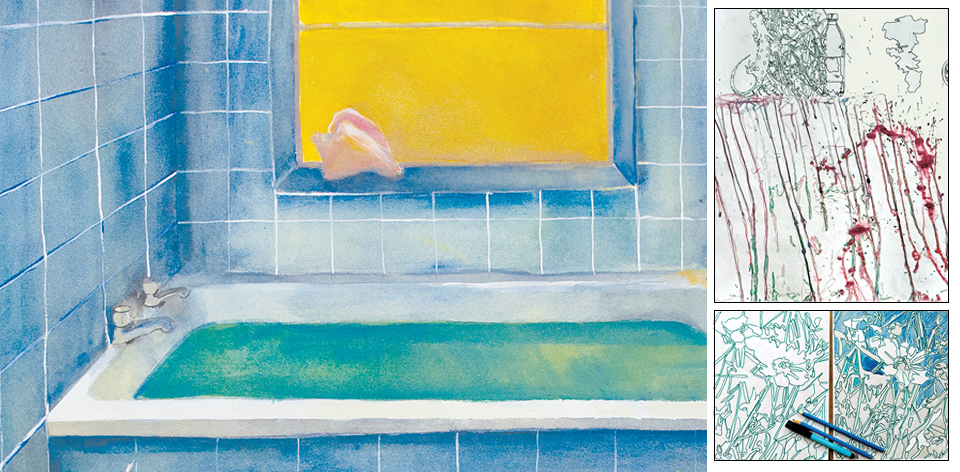In the artwork, a surreal dream-like bathroom environment depicts a seashell resting on a window sill above a full tub of water illustrated in soft low intensity gouache paint. A woman's legs, feet and toes are submerged under water. A close up on the sea shell takes a dive into the shell's crevasse (or is this the woman's mouth? vagina?) into a high contrast garish abstract environment. Boundaries between water, skin, space, and time dissolve into ameboid shapes that swim through the skin of the figure.
This narrative of interconnection between watery environment and human body makes me think of my art workshop titled Drawing Playa Wetlands. The workshop focuses on the formal drawing strategies of continuous line drawing and negative space to understand interconnection and/or boundaries between the seen and unseen components of a wetland ecosystem. Students study a diagram of how playa recharge functions and ideally visit a playa wetland.
They experience the marshy growth of coreopsis, spikerush, pink smartweed, and curly dock plants. They encounter mosquitos, frogs, bugs, birds and ducks above large clay cracks where they clay bottom is dry; and they view the playa gradually give way to grasslands as it spreads out in a large shallow basin.

What they are unable to view is the aquifer below. Wells and wetlands cloud up portals to the underground water 100 to 200 feet below the earth's surface. Like Reeve's shell, which opens into an unseen world through a crevasse, students learn that the play wetlands are portals to deep unseen fossil water. They learn that rain fills up shallow basins called playas and the water slows makes its way into the ground. Theses portals remind us off how little we know about our environment.
The complex mechanics of a playa wetland that recharges an aquifer and Reeve's animation illustrates ecosystems. The bathtub becomes a science-fiction pool, and/or a portal to outer space and/or a universe full of tiny creatures. Ameboid like shapes flow through our hands and feet. Each orifice, crevasses, organ, moving with life, growth, death. Where is the edge of this environment? When the boundary of our skin is broken in this underworld who are we?
The shell crevasse in Reeve's animation and the earth crack within dried up playa wetlands that remind us that our skin, a porous organ, breathes in the environment we move through. Both Reeve's animation and my workshop visually piece together systems of seeing that tell us we are unknown and under-discovered to ourselves. What is the consequence of inhabiting a body or a wetland environment that we are perpetually rediscovering?
is a Full Professor and Coordinator of the Foundations Area at the School of Art, TTU. To learn more about her work visit: carolflueckiger.com

